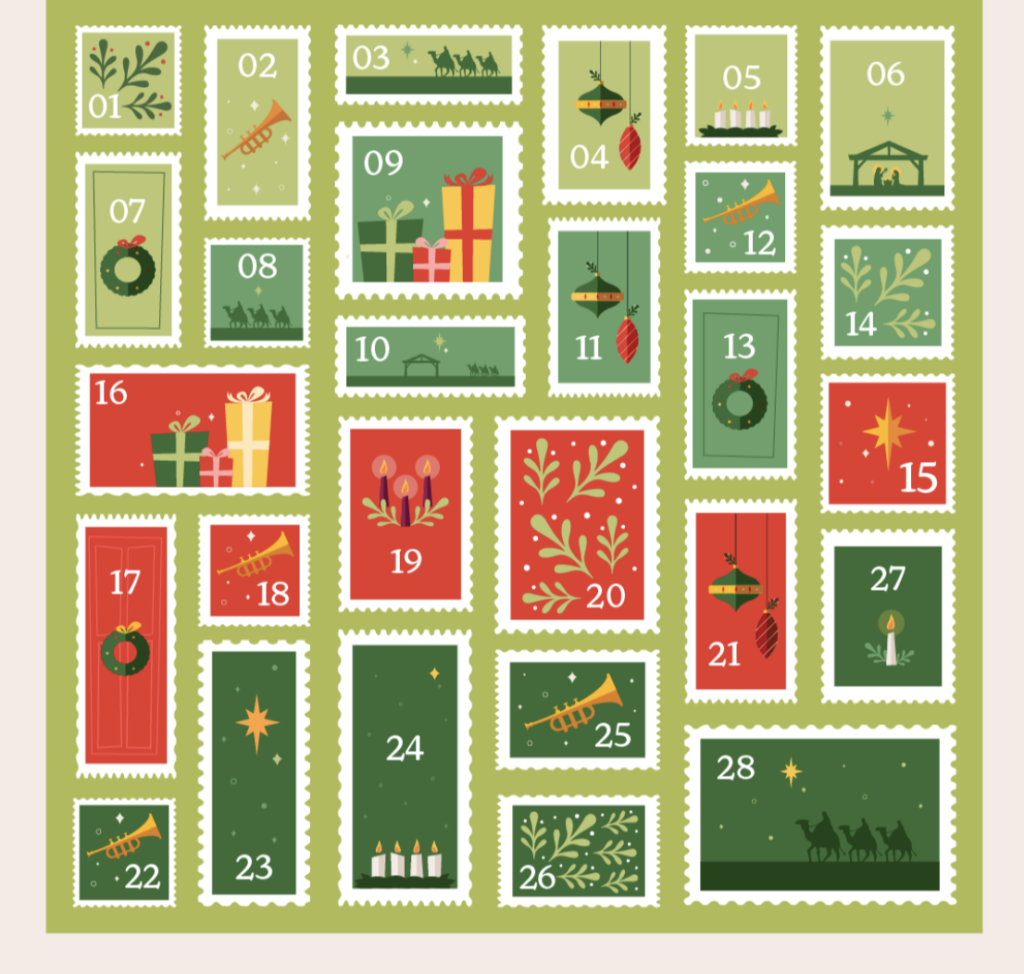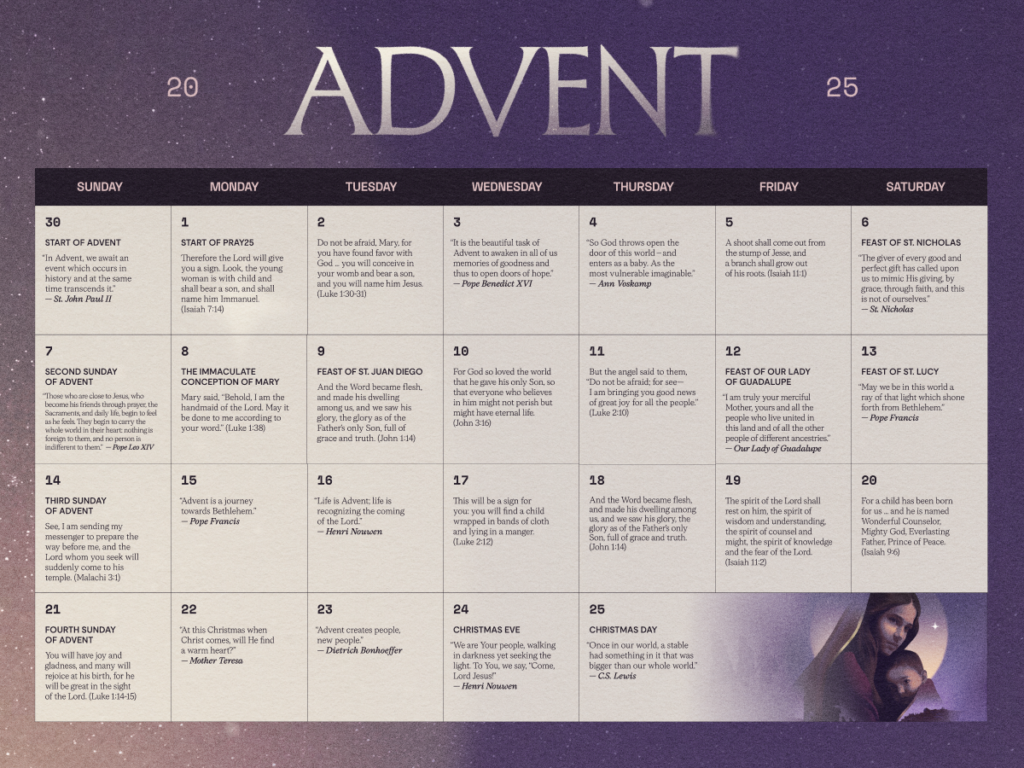Advent Calendars: Table of Content
- Introduction
- What are Advent calendars?
- History of Advent calendars
- Are Advent calendars necessarily religious?
- Importance of Advent calendars
- How Advent calendars work
- Printable Advent calendars
- DIY Advent calendars
- Bible verses for Advent calendars
- More Advent resources
Certain elements of Christian belief have transcended the strictly religious realm and become popular in the secular world.
For example, ever hear the phrase “Hail Mary” while watching a football game on television?
Advent calendars certainly qualify for this distinction. From modest beginnings in Germany to every big box store in America, Advent calendars seemingly have never been more popular.
What are Advent calendars?
Advent calendars are simply calendars that span roughly four weeks from the start of Advent until Christmas.
Advent calendars can help us participate more actively in the season of Advent as we await the joyful celebration of Christmas. They can remind us to pray each day and help us to remember that in our preparation for Christmas, we are awaiting the birth of Jesus.
In a more secular context, Advent calendars count down the days until Christmas and provide a small gift or goodie on each day. Everyone from Dr. Who to Star Wars to Jimmy Choo has an Advent Calendar in 2025.
Advent calendars can be made of cardboard, printed on paper, knitted with fabric, or creatively constructed in some other way. Advent calendars can even be entirely digital.
The history of Advent calendars
Advent calendars probably existed earlier than we have actual evidence for them. They seem to have emerged from Lutheran communities in Germany in the 19th century, where parents and children used chalk marks to track the days until Christmas.
Gerhard Lang most likely created the first printed Advent calendars in the early 20th century, inspired by a calendar his mother made when he was a child in the late 1800s.
Vintage Advent calendars from time periods such as the 1960s and 1980s show that, although designs have evolved, the nucleus of the Advent calendar has remained the same.
Now, Advent calendars exist in many forms, with many themes. For as popular as they have become, they can still be a helpful component to our faith lives in November and December.
Are Advent calendars religious?
Traditionally, Advent calendars have been inherently religious.
In 2023, they are now popular among religious and non-religious alike. On retail sites, the most popular Advent calendars contain Christmas themes, images and colors but lack specific references to Jesus or Christianity.
Catholic Advent calendars normally contain Bible verses, quotes from saints and other religious references.
The importance of Advent calendars
According to the USCCB, Advent calendars “can help you fully enter into the season with daily activity and prayer suggestions to prepare you spiritually for the birth of Jesus Christ.”
Similar to Advent wreaths and candles, Advent calendars are devotions that guide our hearts and minds towards Jesus.
Since there is some verse, quote or item associated with each day, Advent calendars can also help us foster good prayer habits. Checking the Advent calendar each morning or evening can remind us to spend a moment in prayer.
Because they are also popular as secular countdowns to Christmas, Advent calendars perhaps can serve as an introduction to the Catholic liturgical season and the religious roots of the calendar.
How Advent calendars work
Advent calendars that fully capture the season of Advent begin with the first Sunday in Advent and span the entire season until Christmas Eve.
Many calendars, both religious and secular, simply start on Dec. 1. Since the exact start of Advent changes each year, beginning on the first day of December is a simple starting point that can be repeated each year.
Calendars normally “count up” until Dec. 25.
Some Advent calendars are advertised as “12 Days of Advent.” These more likely are a better fit for the days following Christmas, from Dec. 26 until January 6, the Epiphany.
Advent calendars involve some sort of activity each day, even if it’s as simple as reading a short Bible verse or quote. Often, Advent calendars contain an element of opening or unwrapping something to reveal a small surprise.
Some Advent calendars available for purchase lack any overt references to Jesus and faith.
Printable Advent calendars
Advent calendars don’t need to be elaborate or expensive.
A simple printout to guide you through each day is all you really need to make your Advent more rooted in preparation for Jesus’s second coming (and, of course, the celebration of His birth.)
The Vatican, under the guidance of Pope Francis, created this Catholic Advent calendar with a focus toward migrants and refugees. This calendar starts on Dec. 1 and counts up to Christmas, with a special prayer or message each day.
The USCCB also creates a calendar for the entire stretch of Advent, starting with the first Sunday of Advent and spanning the four weeks that follow.
DIY Advent calendars
Sometimes the best Advent calendars are the ones you make yourself.
Create a simple Advent calendar yourself by filling out this blank calendar with one prayer intention, quote or scripture verse each day.
Saint Anne’s Helper also has a great do-it-yourself calendar that is great for kids.
Keep it semi-homemade by ordering an Advent calendar kit that you can customize for yourself.
Bible verses for Advent calendars
As you’re thinking about Bible verses for your Advent calendar, focus on shorter lines from scripture.
The first few chapters from both the Gospel of Matthew and Gospel of John are popular choices to include in Advent calendars.
Isaiah and Psalms also provide many options for Advent calendar Bible verses.

